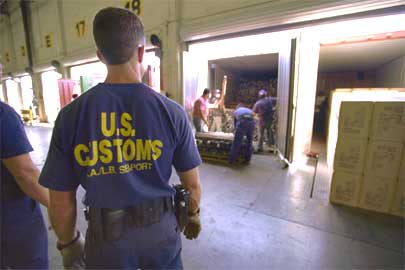|
programs for agricultural invasive pests
The U.S. and most of its trading partners have adopted or endorsed policies
to lower trade barriers and encourage international trade under such international
agreements as the World Trade Organization (WTO), the North American Free
Trade Agreement (NAFTA), and the proposed Free Trade Agreement of the
Americas (FTAA). At the same time, the U.S. and its trading partners conduct
negotiations to prevent and control invasions of nonnative species under
the International Plant Protection Convention, and the Convention on International
Trade in Endangered Species of Wild Flora and Fauna.
In addition, nations establish regulations under the WTO Agreement on
the Application of Sanitary and Phytosanitary Measures to prevent the
spread of invasive species through trade flows. The International Office
of Epizootics (OIE) harmonizes trade regulations in animals and animal
products for member nations, as well as providing information about the
occurrence and control of animal diseases and international coordination
of studies concerning surveillance and control of such diseases.

In the U.S., a number of Federal departments and agencies address invasive
species. Executive
Order 13112 in 1999 created the National Invasive Species Council,
which includes the Departments of Agriculture, Commerce, Defense, Interior,
State, Transportation, and Treasury, and the Environmental Protection
Agency. Within USDA, the Animal and Plant Health Inspection Service (APHIS)
has a major role in preventing and controlling invasive crop pests and
livestock diseases, while other agencies support research and technical
and financial assistance.
The primary programs for managing invasive species are pest exclusion,
surveillance, and control (including eradication and longer term management).
APHIS is the primary
Federal agency addressing agricultural pests, but port-of-entry inspections
are handled by a former component of APHIS and the former Customs Service
in what is now the Bureau of Customs
and Border Inspection under the Department of Homeland Security.

Exclusion programs
include port-of-entry inspections of passengers, baggage, and freight
entering the U.S. from other countries, which sometimes occur in the country
of origin, and offshore
programs to monitor and control specific pests in other countries
and prevent their entry into the U.S. Exclusion programs identify pests
to exclude, goods that can be imported from specific countries, and inspections,
treatments, or other practices required of goods or means of storage and
transportation to meet U.S.
animal health or phytosanitary standards for entry.

 However,
exclusion programs cannot be perfect, so APHIS also cooperates with States
to detect and monitor pests in the U.S. and has a variety of programs
to eradicate or manage some pests that have entered the U.S. APHIS
has special programs to address new discoveries of some invasive pests
that have the potential to cause severe damage to agricultural production
or to cause other countries to stop purchasing U.S. agricultural exports.
APHIS also certifies that U.S. exports meet the animal
health and phytosanitary
requirements of other countries. However,
exclusion programs cannot be perfect, so APHIS also cooperates with States
to detect and monitor pests in the U.S. and has a variety of programs
to eradicate or manage some pests that have entered the U.S. APHIS
has special programs to address new discoveries of some invasive pests
that have the potential to cause severe damage to agricultural production
or to cause other countries to stop purchasing U.S. agricultural exports.
APHIS also certifies that U.S. exports meet the animal
health and phytosanitary
requirements of other countries.
A number of Federal laws govern USDA policies and actions, including
the Plant Protection Act, the Federal Seed Act, the Noxious Weed
Act, the Animal Damage Control Act, and the Animal Health Protection
Act. In addition, under various laws concerning public land management,
research, and cooperation with Federal, State, and private entities,
the Forest Service has a major role in preventing and controlling
invasive pests on public and private forests and grasslands.
Important policies include protection or exclusion (risk assessments,
lists of excluded or permitted species, preclearance of import shipments,
inspection, quarantines, and treatment), early detection of species that
have entered and rapid response with control or eradication measures,
control or management of species that have become established, and international
cooperation to control or prevent the spread of species. In addition,
crop insurance and indemnification programs can mitigate the damages of
these pests. In some circumstances, growers control or manage established,
nonnative pests without government assistance.
for more information, contact:
Craig Osteen
web administration: webadmin@ers.usda.gov
page updated: March 17, 2003
|
 |
|